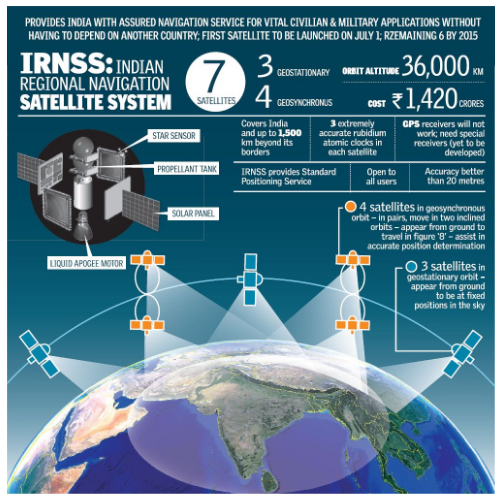Context:
A few weeks ago, a large object found on the shores of western Australia has been confirmed to be the debris of an Indian Space Research Organisation (ISRO) rocket.
- It was most likely an unburned part of the PSLV rocket that launched a navigation satellite for the Indian Regional Navigation Satellite System (IRNSS) constellation two months ago.
- This incident raises concerns about space debris and its adverse impact on Earth and its inhabitants.
 Image Source: PWOnlyIAS Video
Image Source: PWOnlyIAS Video
Earlier Such Instances in the World:
- A large chunk of a 25-tonne Chinese rocket fell into the Indian Ocean in May 2021.
- The most famous such case remains that of the Skylab space station, a predecessor to the currently operational International Space Station, which disintegrated in 1979.
- Large chunks from this disintegration fell into the Indian Ocean, some of them falling on land in western Australia.
Space Debris:
- It refers to the collection of artificial objects in orbit around the Earth that are no longer in use.
- These objects include non-functional spacecraft, abandoned launch vehicle stages, mission-related debris, and fragmentation debris.
Threats with such Debris:
- Threat to Life and Property: The threat to life and property from falling space junk is not negligible.
- Threat to Marine Life & A Source of Pollution: Such large objects falling into oceans can be a threat to marine life, and a source of pollution.
- Frequency of Incidents: There are no recorded incidents of falling space objects causing any appreciable damage on Earth.
- Whenever they have dropped over land have generally occurred in uninhabited areas.
International Regulations and Conventions:
- Convention on International Liability for Damage Caused by Space Objects or The Liability Convention, 1972:
- Most space-faring countries are signatories to this Convention.
- This convention is one of the several international agreements that complement the Outer Space Treaty, the overarching framework guiding the behavior of countries in space.
- The Outer Space Treaty:
- It was adopted by the United Nations in 1967.
- It primarily addresses the peaceful use of outer space and prohibits the placement of nuclear weapons in space.
- It also contains provisions related to space debris and the return of space objects to Earth.
- It mainly deals with damage caused by space objects to other space assets.
- It also applies to damage caused by falling objects on earth.
- Absolutely Liable to pay Compensation: The Convention makes the launching country “absolutely liable” to pay compensation for any damage caused by its space object on the earth or to a flight in air.
- The amount of compensation is to be decided “in accordance with international law and the principles of justice and equity”.
- Example of Paying Compensation:
- Only once this compensation has resulted so far.
- Canada sought damages from the then Soviet Union, for a satellite with radioactive substance that fell into an uninhabited region in its northern territory in 1978 and the Soviet Union is reported to have paid 3 million Canadian dollars.
- What about in the current case?
- If the PSLV junk had caused any damage in Australia, India could have been liable to pay compensation, even if the object fell into the ocean and was then swept to the shores.
Steps Taken to Mitigate Space Debris:
- Unique Scientific Experiment by ISRO:
- ISRO successfully conducted a dedicated commercial mission, placing seven Singaporean satellites into intended orbits on board a PSLV rocket that aims to address space debris mitigation problems and preserve valuable orbits for future satellite deployments.
- Orbit-lowering Experiment: ISRO performed a unique experiment, lowering the fourth stage of the rocket into a 300 km high orbit after placing customer satellites at an altitude of 536 km to mitigate space debris concerns.
- Reducing Debris Duration: Because of the orbit-lowering experiment, the duration of the stage in space has been significantly reduced to “two months.”
- IS 4 OM:
- In 2022, ISRO set up the System for Safe and Sustainable Operations Management (IS 4 OM) to continually monitor objects posing collision threats.
- Project NETRA:
- It is an early warning system in space to detect debris and other hazards to Indian satellites.
- RemoveDebris of European Space Agency:
- It is for the removal demonstration mission in low Earth orbit (LEO) that aims to test and validate multiple active debris removal technologies.
- Debris Elimination and Reentry of USA (NASA):
- It aims to reduce the threat of re-entering debris and mitigate the growth of space debris.
- Space Debris Mitigation Guidelines of the Inter-Agency Space Debris Coordination Committee (IADC):
- It is to provide a set of best practices for reducing the generation of space debris and mitigating the impact of existing debris on operational spacecraft and infrastructure.
- Space Debris Capture Experiment of Japan (JAXA):
- It is to demonstrate the feasibility of capturing space debris using a device mounted on a spacecraft and to study the characteristics of space debris.
Conclusion:
Like a coin, the opening of the space domain has its two faces too. While it has brought many benefits to humans, it has also presented the challenge of space debris.
The sorting of space debris is crucial for the continued safe and sustainable use of outer space. To come out with the desired results, there is a need to prioritize collaborative actions by the international communities.
News Source: The Indian Express
To get PDF version, Please click on "Print PDF" button.
 Image Source: PWOnlyIAS Video
Image Source: PWOnlyIAS Video